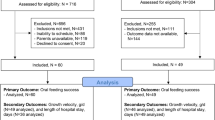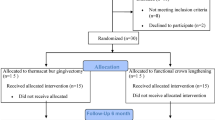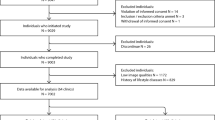Abstract
Background
Pharyngeal contractility is critical for safe bolus propulsion. Pharyngeal contractile vigor can be measured by Pharyngeal Contractile Integral (PhCI): product of mean pharyngeal contractile amplitude, length, and duration. We characterized PhCI in neonates and examined the hypothesis that PhCI differs with mode of stimulation.
Methods
Nineteen neonates born at 38.6 (34–41) weeks gestation were evaluated at 42.9 (40.4–44.0) weeks postmenstrual age using high-resolution manometry (HRM). PhCI was calculated using: (a) Conventional and (b) Automated Swallow Detection algorithm (ASDA) methods. Contractility metrics of all pharyngeal regions were examined using mixed statistical models during spontaneous and adaptive state (pharyngeal and oral stimulus) swallowing.
Results
PhCI of oral stimuli swallows were distinct from pharyngeal stimuli and spontaneous swallows (P < 0.05). Correlation between conventional and ASDA methods was high (P < 0.001). PhCI increased with swallows for pharyngeal stimulation (P < 0.05) but remained stable for swallows with oral stimulation. PhCI differed between proximal and distal pharynx (P < 0.001).
Conclusions
PhCI is a novel reliable metric capable of distinguishing (1) proximal and distal pharyngeal activity, (2) effects of oral and pharyngeal stimulation, and (3) effects of prolonged stimulation. Changes in pharyngeal contractility with maturation, disease, and therapies can be examined with PhCI.
Similar content being viewed by others
Log in or create a free account to read this content
Gain free access to this article, as well as selected content from this journal and more on nature.com
or
References
Arvedson, J. C. & Lefton-Greif, M. A. Anatomy, physiology, and development of feeding. Semin. Speech Lang. 17, 261–268 (1996).
Miller, L. et al. Physiology of the upper segment, body, and lower segment of the esophagus. Ann. N. Y. Acad. Sci. 1300, 261–277 (2013).
Jadcherla, S. R., Gupta, A., Stoner, E., Fernandez, S. & Shaker, R. Pharyngeal swallowing: defining pharyngeal and upper esophageal sphincter relationships in human neonates. J. Pediatr. 151, 597–603 (2007).
Jadcherla, S. R. et al. Upper and lower esophageal sphincter kinetics are modified during maturation: effect of pharyngeal stimulus in premature infants. Pediatr. Res. 77, 99–106 (2014).
Hasenstab, K. A., Sitaram, S., Lang, I. M., Shaker, R. & Jadcherla, S. R. Maturation modulates pharyngeal-stimulus provoked pharyngeal and respiratory rhythms in human infants. Dysphagia 32, 509–519 (2017).
Hasenstab, K. A. & Jadcherla, S. R. Respiratory events in infants presenting with apparent life threatening events: is there an explanation from esophageal motility? J. Pediatr. 165, 250–255 e251 (2014).
Dua, K., Surapaneni, S. N., Kuribayashi, S., Hafeezullah, M. & Shaker, R. Pharyngeal airway protective reflexes are triggered before the maximum volume of fluid that the hypopharynx can safely hold is exceeded. Am. J. Physiol. Gastrointest. Liver Physiol. 301, G197–G202 (2011).
Dua, K., Surapaneni, S. N., Kuribayashi, S., Hafeezullah, M. & Shaker, R. Protective role of aerodigestive reflexes against aspiration: study on subjects with impaired and preserved reflexes. Gastroenterology 140, 1927–1933 (2011).
Jadcherla, S. R. et al. Definition and implications of novel pharyngo-glottal reflex in human infants using concurrent manometry ultrasonography. Am. J. Gastroenterol. 104, 2572–2582 (2009).
Jadcherla, S. R. et al. Effect of nasal non-invasive respiratory support methods on pharyngeal provocation induced aero-digestive reflexes in infants. Am. J. Physiol. Gastrointest. Liver Physiol. 310, G1006–G1014 (2016).
Jadcherla, S. R. et al. Upper and lower esophageal sphincter kinetics are modified during maturation: effect of pharyngeal stimulus in premature infants. Pediatr. Res. 77, 99–106 (2015).
McGrattan, K. E., Sivalingam, M., Hasenstab, K. A., Wei, L. & Jadcherla, S. R. The physiologic coupling of sucking and swallowing coordination provides a unique process for neonatal survival. Acta Paediatr. 105, 790–797 (2016).
Jadcherla, S. R., Duong, H. Q., Hoffmann, R. G. & Shaker, R. Esophageal body and upper esophageal sphincter motor responses to esophageal provocation during maturation in preterm newborns. J. Pediatr. 143, 31–38 (2003).
Jadcherla, S. R., Hoffmann, R. G. & Shaker, R. Effect of maturation of the magnitude of mechanosensitive and chemosensitive reflexes in the premature human esophagus. J. Pediatr. 149, 77–82 (2006).
Jadcherla, S. R., Gupta, A., Coley, B. D., Fernandez, S. & Shaker, R. Esophago-glottal closure reflex in human infants: a novel reflex elicited with concurrent manometry and ultrasonography. Am. J. Gastroenterol. 102, 2286–2293 (2007).
Jensen, P. S. et al. Pharyngeal stimulus-induced reflexes are impaired in infants with perinatal asphyxia: does maturation modify?. Neurogastroenterol. Motil. 29, 7(2017). https://doi.org/10.1111/nmo.13039.
Chun, R. et al. Endoscopic cricopharyngeal myotomy for management of cricopharyngeal achalasia (CA) in an 18-month-old child. Laryngoscope 123, 797–800 (2013).
Arvedson, J. C., Brodsky, L. Pediatric Swallowing and Feeding: Assessment and Management. Singular Publishing Group: San Diego, California, 1992.
Shubert, T. R. & Sitaram, S. & Jadcherla, S. R. Effects of pacifier and taste on swallowing, esophageal motility, transit, and respiratory rhythm in human neonates. Neurogastroenterol Motil. 28(4), 532–542 (2016).
Nativ-Zeltzer, N., Logemann, J. A., Zecker, S. G. & Kahrilas, P. J. Pressure topography metrics for high-resolution pharyngeal-esophageal manofluorography-a normative study of younger and older adults. Neurogastroenterol. Motil. 28, 721–731 (2016).
Jiao, H. et al. A human model of restricted upper esophageal sphincter opening and its pharyngeal and UES deglutitive pressure phenomena. Am. J. Physiol. Gastrointest. Liver Physiol. 311, G84–G90 (2016).
Shaker, R. et al. Effects of laryngeal restriction on pharyngeal peristalsis and biomechanics: clinical implications. Am. J. Physiol. Gastrointest. Liver Physiol. 310, G1036–G1043 (2016).
Yoon, K. J., Park, J. H. & Jung, I. S. Videofluoroscopic and manometric evaluation of pharyngeal and upper esophageal sphincter function during swallowing. J. Neurogastroenterol. Motil. 20, 352–361 (2014).
Balasubramanian, G. et al. Characterization of pharyngeal peristaltic pressure variability during volitional swallowing in healthy individuals. Neurogastroenterol. Motil. 29, 11 (2017). https://doi.org/10.1111/nmo.13119.
Kern, M. K. et al. Pharyngeal peristaltic pressure variability, operational range and functional reserve. Am. J. Physiol. Gastrointest. Liver Physiol. 312, G516–G525 (2017).
Rosen, S. P., Jones, C. A. & McCulloch, T. M. Pharyngeal swallowing pressures in the base-of-tongue and hypopharynx regions identified with three-dimensional manometry. Laryngoscope 127, 1989–1995 (2017).
McCulloch, T. M., Hoffman, M. R. & Ciucci, M. R. High-resolution manometry of pharyngeal swallow pressure events associated with head turn and chin tuck. Ann. Otol. Rhinol. Laryngol. 119, 369–376 (2010).
Jadcherla, S. R. et al. Evaluation and management of neonatal dysphagia: impact of pharyngoesophageal motility studies and multidisciplinary feeding strategy. J. Pediatr. Gastroenterol. Nutr. 48, 186–192 (2009).
Pandolfino, J. E., Fox, M. R., Bredenoord, A. J. & Kahrilas, P. J. High-resolution manometry in clinical practice: utilizing pressure topography to classify oesophageal motility abnormalities. Neurogastroenterol. Motil. 21, 796–806 (2009).
Goldani, H. A., Staiano, A., Borrelli, O., Thapar, N. & Lindley, K. J. Pediatric esophageal high-resolution manometry: utility of a standardized protocol and size-adjusted pressure topography parameters. Am. J. Gastroenterol. 105, 460–467 (2010).
Jadcherla, S. R. et al. Esophageal sensation in premature human neonates: temporal relationships and implications of aerodigestive reflexes and electrocortical arousals. Am. J. Physiol. Gastrointest. Liver Physiol. 302, G134–G144 (2012).
Barlow, S. M. Central pattern generation involved in oral and respiratory control for feeding in the term infant. Curr. Opin. Otolaryngol. Head. Neck. Surg. 17, 187–193 (2009).
Logemann, J. A. Swallowing disorders. Best. Pract. Res. Clin. Gastroenterol. 21, 563–573 (2007).
Jadcherla, S. R., Hasenstab, K. A., Shaker, R. & Castile, R. G. Mechanisms of cough provocation and cough resolution in neonates with bronchopulmonary dysplasia. Pediatr. Res. 78, 462–469 (2015).
van den Engel-Hoek, L., van Hulst, K. C., van Gerven, M. H., van Haaften, L. & de Groot, S. A. Development of oral motor behavior related to the skill assisted spoon feeding. Infant. Behav. Dev. 37, 187–191 (2014).
O’Rourke, A., Humphries, K., Lazar, A. & Martin-Harris, B. The pharyngeal contractile integral is a useful indicator of pharyngeal swallowing impairment. Neurogastroenterol. Motil. 29, 1–7 (2017).
Ryu, J. S., Park, D. H. & Kang, J. Y. Application and interpretation of high-resolution manometry for pharyngeal dysphagia. J. Neurogastroenterol. Motil. 21, 283–287 (2015).
Knigge, M. A., Thibeault, S. & McCulloch, T. M. Implementation of high-resolution manometry in the clinical practice of speech language pathology. Dysphagia 29, 2–16 (2014).
Acknowledgements
We are grateful to Carissa Collins, BS, BME, for technical support with manometric waveforms and contour plots; Brittany Durr, RN, MHA, for clinical coordination efforts and data extraction; and Lai Wei, PhD for statistical consultations. This study was supported in part by National Institutes of Health Grants RO1 DK-068158 (Jadcherla) and PO1 DK-068051 (Shaker, Lang, Jadcherla)
Author information
Authors and Affiliations
Contributions
S.R.J. developed the concepts, study design, obtained grant funding and ethical approvals from IRB. M.K., G.B., and R.S. were also associated in concepts. S.R.J. and K.A.H. performed high-resolution pharyngeal manometry studies for data acquisition. S.R.J., V.P., K.A.H., and S.N. performed data analysis. V.P. developed automated analytical algorithms. S.N. performed statistical analysis and interpretation. J.D. provided guidance with mathematical concepts and analytical algorithms. S.R.J., V.P., K.A.H., S.N., J.D., M.K., G.B., and R.S. performed data verification and interpretation. V.P., K.A.H., and S.N. created figures and tables. S.R.J., V.P., K.A.H., S.N., J.D., M.K., G.B., and R.S. were involved with manuscript writing, editing, and approval of final version.
Corresponding author
Ethics declarations
Competing interests
The authors declare no competing interests.
Additional information
Publisher's note: Springer Nature remains neutral with regard to jurisdictional claims in published maps and institutional affiliations.
Rights and permissions
About this article
Cite this article
Jadcherla, S.R., Prabhakar, V., Hasenstab, K.A. et al. Defining pharyngeal contractile integral during high-resolution manometry in neonates: a neuromotor marker of pharyngeal vigor. Pediatr Res 84, 341–347 (2018). https://doi.org/10.1038/s41390-018-0097-6
Received:
Revised:
Accepted:
Published:
Issue date:
DOI: https://doi.org/10.1038/s41390-018-0097-6
This article is cited by
-
Modulation of Pharyngoesophageal Motility Characteristics During Concurrent Oral Feeding in Infants: Novel Pilot Observations
Dysphagia (2025)
-
High-Resolution Pharyngeal Manometry: Recent Developments and Future Directions
Current Otorhinolaryngology Reports (2023)
-
Accuracy of High-Resolution Pharyngeal Manometry Metrics for Predicting Aspiration and Residue in Oropharyngeal Dysphagia Patients with Poor Pharyngeal Contractility
Dysphagia (2022)
-
Mechanisms and management considerations of parent-chosen feeding approaches to infants with swallowing difficulties: an observational study
Scientific Reports (2021)
-
High-Resolution Pharyngeal Manometry and Impedance: Protocols and Metrics—Recommendations of a High-Resolution Pharyngeal Manometry International Working Group
Dysphagia (2020)



